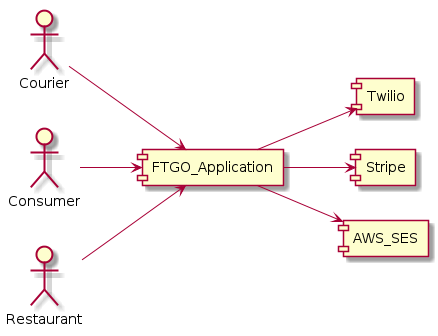Understanding an architecture: part 1 - system context
application architecture architecture documentation architectingContact me for information about consulting and training at your company.
The MEAP for Microservices Patterns 2nd edition is now available
Recently, I was talking with a friend, who is a software architect, about his upcoming new job. He asked me about how I learn a new architecture. I walked him through the process that I use during a microservices consulting engagement to understand a client’s existing architecture.
This is the first of a series of posts that explain the steps of the process. These steps also correspond to sections of an architecture document. The other articles in the series are:
I’ll use the FTGO application from my Microservices Patterns book as an example. Here is the vision statement for this application:
FTGO is a food delivery application. Consumers use FTGO to place food orders at local restaurants. FTGO coordinates a network of couriers who deliver the orders. It also pays couriers and restaurants. Restaurants use the FTGO website to edit their menus and manage orders
Since an application exists to enable ‘users’ to accomplish their goals, I like to start on the outside by learning about (and documenting) the system context.
The system context
The system context is the black box model of the application. It consists of the following elements:
- the application
- the actors - humans and other applications that use the application - and their goals
- the responsibilities of the key external services/applications used by the application
The system context is documented using some combination of diagrams and text. It’s often useful to create a diagram that visualizes the system context model. For example, here is the system context diagram for the FTGO application:

See OMG are you still using Rational Rose? for an explanation of this diagram’s visual notation along with important architecture documentation concepts.
The documentation must also describe the goals of the actors and responsibilities the external services. For example, for the FTGO application, the key actors are:
- Consumer - places orders at restaurants
- Restaurant - manages the menu and prepares the food
- Courier - delivers the order
The key external services/applications are:
- Stripe - charging consumer credit cards
- Twilio - sending text messages
- Amazon Simple Email Service (SES) - sending emails
You might find it useful to incorporate this information into the diagram. Alternatively, you might skip the diagram entirely since it’s essentially a list of actors and services/application. You could, for example, present the information in a table.
What’s next
In the next article, I explain the next step: understanding/documenting key user stories and scenarios.
Need help adopting microservices?
I provide consulting and training.


 Premium content now available for paid subscribers at
Premium content now available for paid subscribers at 




